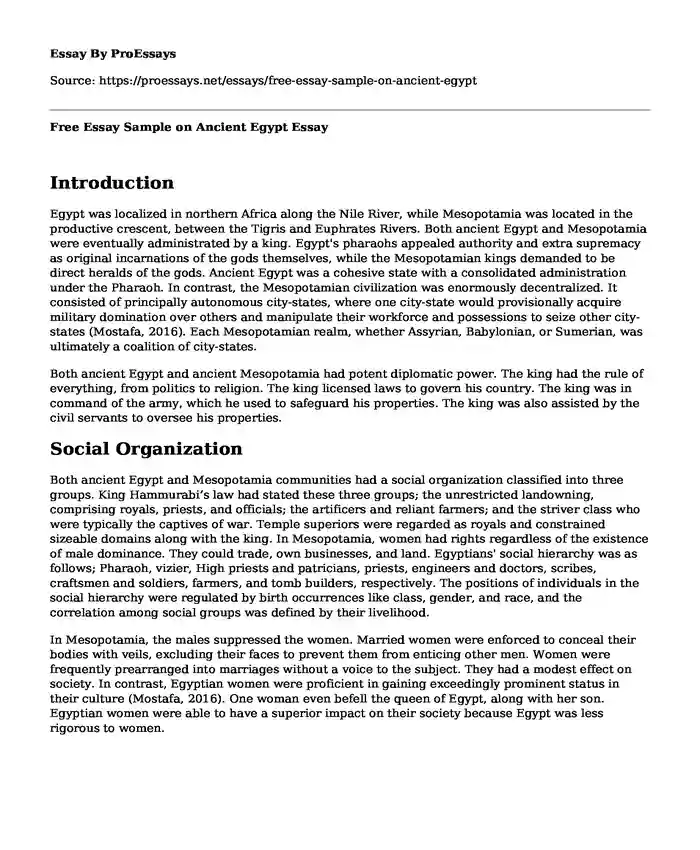Introduction
Egypt was localized in northern Africa along the Nile River, while Mesopotamia was located in the productive crescent, between the Tigris and Euphrates Rivers. Both ancient Egypt and Mesopotamia were eventually administrated by a king. Egypt's pharaohs appealed authority and extra supremacy as original incarnations of the gods themselves, while the Mesopotamian kings demanded to be direct heralds of the gods. Ancient Egypt was a cohesive state with a consolidated administration under the Pharaoh. In contrast, the Mesopotamian civilization was enormously decentralized. It consisted of principally autonomous city-states, where one city-state would provisionally acquire military domination over others and manipulate their workforce and possessions to seize other city-states (Mostafa, 2016). Each Mesopotamian realm, whether Assyrian, Babylonian, or Sumerian, was ultimately a coalition of city-states.
Both ancient Egypt and ancient Mesopotamia had potent diplomatic power. The king had the rule of everything, from politics to religion. The king licensed laws to govern his country. The king was in command of the army, which he used to safeguard his properties. The king was also assisted by the civil servants to oversee his properties.
Social Organization
Both ancient Egypt and Mesopotamia communities had a social organization classified into three groups. King Hammurabi’s law had stated these three groups; the unrestricted landowning, comprising royals, priests, and officials; the artificers and reliant farmers; and the striver class who were typically the captives of war. Temple superiors were regarded as royals and constrained sizeable domains along with the king. In Mesopotamia, women had rights regardless of the existence of male dominance. They could trade, own businesses, and land. Egyptians' social hierarchy was as follows; Pharaoh, vizier, High priests and patricians, priests, engineers and doctors, scribes, craftsmen and soldiers, farmers, and tomb builders, respectively. The positions of individuals in the social hierarchy were regulated by birth occurrences like class, gender, and race, and the correlation among social groups was defined by their livelihood.
In Mesopotamia, the males suppressed the women. Married women were enforced to conceal their bodies with veils, excluding their faces to prevent them from enticing other men. Women were frequently prearranged into marriages without a voice to the subject. They had a modest effect on society. In contrast, Egyptian women were proficient in gaining exceedingly prominent status in their culture (Mostafa, 2016). One woman even befell the queen of Egypt, along with her son. Egyptian women were able to have a superior impact on their society because Egypt was less rigorous to women.
Writing System
The ancient Egyptians formulated a writing system called Hieroglyphics, which they wrote on papyrus. They also industrialized designs such as the sphinx and pyramid. They had significant innovation in art and medicine, and they crafted a solar calendar. In Mesopotamia, writing emerged over 5,000 years ago (Mostafa, 2016). The ancient people of Mesopotamia created a writing system called Cuneiform, which was the first language. Besides, they established math that is still used today. They had grand architecture like the ziggurats.
In Mesopotamia, organized religion had its early development while in Egypt, more than five thousand years ago. The religious schemes in these areas merged politically with spiritual rudiments in a type of government known as a theocracy, that is reign by blissful guidance. Both ancient Egypt and ancient Mesopotamia were polytheistic; they worshipped many gods. They both had gods of the earth, the sky, the sun, freshwater, and the gods zealous to human sensations and the underworld. In Mesopotamia, the natures' intensities were more hectic, more likely to trigger calamities such as disastrous flooding. Therefore, the gods were perceived as volatile beings who had to be reserved gratified by the priests because of their peculiar powers. In Egypt, nature was less caustic; hence the gods were regarded as humane, plentiful, and well inclined to the human race.
Conclusion
Ancient Egypt and Mesopotamia centered their wealth on agriculture. Each farmer paid excises in the form of grain. In the occurrence of famine, the grain was used to sustain the people. In both societies, trading was a corporate aspect. In both communities, industrial interaction was massive with the outer world (Anis, 2017).
Mesopotamians were incredibly innovative people. It is alleged that they devised the sailboat, the wheel, and the chariot. They established a technique of math that is used to date. They centered their math on the number 60. Today, in a circle, there are 360 degrees. They also developed the game of checkers. Egyptians invented pyramids, which are among the main historic sites and tourist attraction sites in Egypt.
References
Anis, A. (2017). Auditors’ and accounting educators’ perceptions of accounting education gaps and audit quality in Egypt. Journal of Accounting in Emerging Economies.
Mostafa, W. (2016). The value relevance of earnings, cash flows and book values in Egypt. Management Research Review.
Cite this page
Free Essay Sample on Ancient Egypt . (2023, Dec 12). Retrieved from https://proessays.net/essays/free-essay-sample-on-ancient-egypt
If you are the original author of this essay and no longer wish to have it published on the ProEssays website, please click below to request its removal:
- Pearl Harbor - Movie Review
- Critique of Dissent From War by Robert Ivie Essay
- Why Did Some Societies Fail to Converge Into Larger Ones in the Face of War and Competition?
- Research Paper on Prescribed Drugs Used by Military Service Members During Vietnam War
- List of Facts Pertaining to Egyptian's Life After Death
- The Influence of Groups in Ancient Societies and Cleopatra's Leadership Essay
- Essay on Comparing the Historical American North and South







